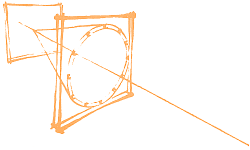Orateur
M.
Lukas Steiger
(Technical University of Liberec)
Description
The COMPASS RICH-1 detector has been using two reflecting segmented spherical mirrors, constructed from 68 hexagonal and 48 pentagonal individual mirrors. All mirrors have three degrees of freedom per segment, i.e., piston, tip, and tilt. The influence of external vibrations, pressure and temperature fluctuation can change alignment of individual mirrors with respect to optimal spherical surface. The accuracy of Cerenkov angle measurement can be increased by monitoring and consequently by compensation of tilt of mirrors.
The on-line measurement of individual mirrors misalignment was made by continues alignment of mirrors - CLAM method. The rectangular grid, made from reflecting continuous lines, is placed near the focal plane of mirror wall inside the detector vessel. The image of lines, reflected by the mirror wall, is observed by 4 cameras. Small misalignment of mirrors can change position of image of the lines at camera CMOS detector.
The cameras were calibrated by using of calibrated plate to receive all information about lenses optical distortions. The developed algorithm enables compensation of these distortions. The photos of rectangular grid before, during and after Compass runs at different conditions were taken. Photogrammetric method was used to determine absolute camera’s positions from images of photogrammetric targets, placed on mirror-wall frame. The absolute values of tilt of mirrors were determined by new algorithm from knowledge of both rectangular grid and photogrammetric targets positions and from localization of camera principal point. The tilts of individual mirrors were determined with a resolution of 0.1 mrad. These results demonstrate that the CLAM method can successfully sense the tilts of a segmented mirror.
| Please indicate "poster" or "plenary" session. Final decision will be made by session coordinators. | poster |
|---|
Auteur
M.
Lukas Steiger
(Technical University of Liberec)
Co-auteur
Dr
Sulc Miroslav
(Technical University of Liberec)

